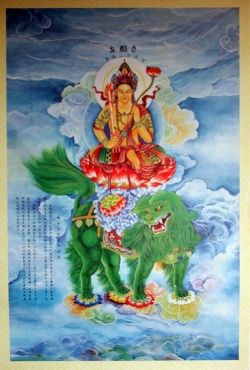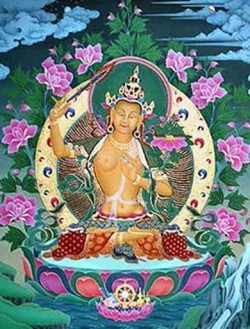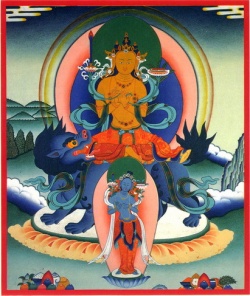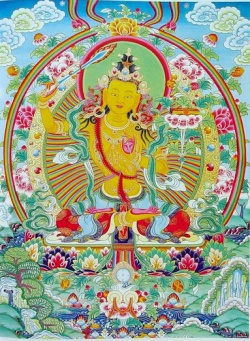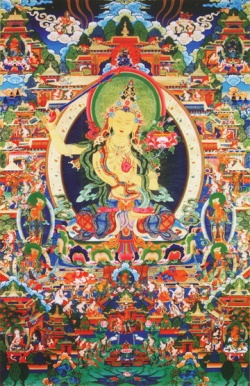Manjushri Sadhana: Front Generation Explanation
So this is the explanation on the front generation. It’s quite good fortune that everybody has the opportunity to be able to do this retreat; and I really encourage you and admire you for doing it. It will bring great benefit to you. If you don’t understand everything about the sadhana at the beginning don’t worry about it, that’s okay. The important thing is to do it as best as you can and to really make a connection with this Buddha of Wisdom, Manjushri, and feel that your own wisdom grows and that you’re protected by wisdom.
Refuge, altruistic intention, and the four immeasurable attitudes
The sadhana starts out with taking refuge and generating bodhicitta. The reason we start out that way is by taking refuge we get this clear in our mind that we’re doing a Buddhist practice so that the Buddha, Dharma, and Sangha are our spiritual guides. When we generate bodhicitta, the altruistic intention to become a Buddha for the benefit of sentient beings, then we are getting clear in our own mind why we’re doing this practice. So we’re not on a power trip. We’re not doing it just to have fun. We’re doing it because we really care about other sentient beings and because we have confidence in our own ability to become a fully enlightened Buddha.
Then we do the four immeasurables: “May all sentient beings have happiness and its causes,” and so on. With that prayer, it is very good to pause and meditate after each line and really generate those feelings – because that helps to purify our mind of anger, and attachment, and bias— and helps us to feel love, compassion, joy, and equanimity.
The next step in the meditation is meditating on emptiness. And here is where we really try and let go of all of our preconception, all of our wrong views, and the whole feeling that, “The way I see the world, that’s exactly how it is,” and, “Things are screwed up,” and, “Nobody does what I want.” And, you know this very hard rigid view that we have. Instead we really just soften that and see that those are only thoughts, they’re not necessarily an objective external reality. So we calm the thoughts. And we open up some space in our mind. And let our mind rest peacefully in this space of the lack of objectified existence out there that we have to battle with. Instead there’s just open space-like wisdom.
Then, within that space of the emptiness of inherent existence, Manjushri appears. He is seated on a lotus and a moon seat. And it’s very important that you visualize everything made of light. So you’re not visualizing a statue or a painting. You might look at the statue or the painting to know how to visualize; but you really want to feel that there’s a real living being there with a body made of light that you can trust, and you can take refuge in, who is an emanation of the wisdom of all the Buddhas.
We do the next section of invoking and absorbing the wisdom beings. That’s a psychological technique because sometimes we visualize Manjushri in front of us and we say, “Oh, that’s not really the Buddha of Wisdom, that’s just my imagination.” So here what we do is we imagine that the light goes out from Manjushri’s heart and invokes all the beings who really are Manjushris, invokes all the Buddhas and bodhisattvas, and that they come and they dissolve into the Manjushri we visualized in front of us. And doing that gives us more confidence and more feeling that Manjushri really is here in front of us. Because if you think about it, a Buddha has an omniscient mind and knows everything that’s happening in the universe. So the Buddha is here right now in that sense. And we can tune in to the Buddha’s wisdom. We can make requests to the Buddha to help us increase our love, and compassion, and wisdom. We just have to believe that the Buddha is there and tune into the Buddha’s energy and make that request.
Making offerings
After we invoke and absorb the wisdom beings into the Manjushri in front, then we make offerings. We didn’t chant the mantras. I’ll do it now in case you’re interested but you don’t need to worry about the mantras so much. The word argham means water for drinking, padyam means water for washing the feet, pushpe is flowers, dhupe is incense, aloke is light, gandhe is perfume, naivedya is food, and shabda is music. And so we offer all of those to Manjushri. So the meaning of the mantra is, “Oh, the noble arya who have wisdom realizing emptiness directly, all of you: Please, I offer to you these different offerings.” I’ll chant this, but you don’t have to chant it, because I don’t want you to get tangled up trying to pronounce Sanskrit!
Om arya vagih shara saparivara argham pratichcha hum svaha
Om arya vagih shara saparivara padyam pratichcha hum svaha
Om arya vagih shara saparivara pushpe pratichcha hum svaha
Om arya vagih shara saparivara dhupe pratichcha hum svaha
Om arya vagih shara saparivara aloke pratichcha hum svaha
Om arya vagih shara saparivara gandhe pratichcha hum svaha
Om arya vagih shara saparivara naivedya pratichcha hum svaha
Om arya vagih shara saparivara shabda pratichcha hum svaha
The reason we make offerings is to create merit, to create good energy by making offerings to the Buddhas, and Manjushri—who is a Buddha. Usually whenever there are beautiful things we like to grasp onto them and keep them for our self. So we tend to be very possessive, very miserly, looking out for how we can get everything we want. So this practice of making offerings is the complete reversal of that. It’s imagining very very beautiful things filling the entire space around you and then offering them to Manjushri. And then we feel so much delight in making offerings. Okay? So instead of grasping onto things: “This is mine, I’m not going to share it with you!” Or feeling like if we give something that we’re going to miss it; you know this kind of poverty we have sometimes. This meditation of imagining offerings and giving them, and Manjushri accepts them with so much bliss and delight, this meditation really helps us to train our mind in taking delight in giving. It frees us from stinginess and miserliness. And it really helps us expand our mind because when we visualize all these beautiful things, our mind automatically becomes happy. So it doesn’t matter what environment you’re in, even if your external environment’s very dreary. If you imagine beautiful things and then you offer them to the Buddhas and bodhisattvas, who you admire and you respect and you imagine they feel bliss, then that makes you feel good.
The same idea is behind offering praise. So the next three verses are of offering praise. Again, usually when there’s praise, when there are compliments, when there are nice things, we want them. We want everybody to notice our good qualities, and say nice things about us, and praise us, and give us a good reputation. So with that kind of mind then we become so ego sensitive. And whenever people don’t treat us as well as we think they should treat us then we get really upset, And that’s of no use to anybody whatsoever. So here instead of craving praise, what we’re doing is we’re giving it. And we’re learning to feel delight by giving praise, by noticing the good qualities of the Buddhas and bodhisattvas and praising those and respecting those [qualities]. That again, it opens our heart because when we can see good qualities in others then we become more receptive to generating those good qualities ourselves. Whereas when we’re all just focused on, “I want to have a good reputation. I want people to praise me,” then we’re not very happy on the inside, are we?
Meditation on the clear appearance of Manjushri
Then the next step of the meditation is to do the meditation on the clear appearance of Manjushri. (So here you can press the pause button on your tape recorder.) The purpose of this meditation is to develop concentration. So here you may again review all the details of what Manjushri looks like in your mind. And then hold your mind single-pointedly, as much as you can, on that image of Manjushri. Now when you’re visualizing you’re not trying to see Manjushri with the same vividness as you would as if he were before you like looking at a picture or something like that. But it is a visualization. And we’re actually visualizing all the time so it’s not that hard to do.
For example if I say, “Think of pizza.” You have a visualization right away in your mind, don’t you? You know what’s on it. You know whether it’s thin crust or thick crust. You know how much cheese. The visualization of pizza is so clear in your mind, even your eyes are open, right? So in the same way what we’re trying to do now is, instead of visualizing pizza which is an object of attachment, we’re trying to visualize Manjushri whose essence is wisdom and compassion.
You may say, “But it’s so much easier to visualize pizza than Manjushri.” Well, it’s just a matter of habituation. Once you practice visualizing Manjushri again and again and again then visualizing Manjushri becomes very very easy. And you’ll even be able to do it with your eyes open. But here at this point you’re really trying to calm your mind and stay on this image of Manjushri as long as you can. Don’t force yourself to do it too long. If the image is still a little bit blurred, that’s okay. If all you get is an orange blob, that’s okay. Just be content with whatever you get. And slowly as you remember again and again what Manjushri looks like, and you’re mindful of that, your visualization over the days and months and years will increase. And the clarity of it will increase.
Mantra recitation and visualizations
Then after you do that, you do the mantra recitation. So there’s one basic mantra recitation and then there are the seven wisdom mantra recitations. When you’re doing these you don’t have to do all of these visualizations in each meditation session. You could do one. You can do two. You can do one visualization in many meditation sessions. You can play around with this a little bit because you have to see what works for you.
When you start: focus on the visualization, and then when you have the feeling of the visualization, then add the mantra. What you want to be doing ultimately is the visualization and the mantra at the same time. Now some of us are more visually-oriented and so when we do this maybe the mantra is just in the background but we’re focusing more on the visualization. Others of us are more hearing-oriented and so maybe we prefer to just rest our mind on the sound of the mantra and the visualization isn’t quite as vivid. It’s going to be different for each person and it’ll also probably be different in each meditation session. So that’s fine.
In the basic visualization here at Manjushri’s heart, the Manjushri in front of you, there’s a moon disc and an orange syllable dhih. And the letters of the mantra om ah ra pa tsa na are standing around the edge of the moon disc. All the letters are standing upright and they’re all made of brilliant light. And so this light shines from the dhih and the syllables and it invokes all the wisdom of explaining, debating, and writing; and the wisdom of hearing, thinking, and meditating of all the Buddhas and bodhisattvas and all the holy beings. And all of that wisdom appears in the form of orange light.
So it’s coming from space where all those holy beings are, all this light coming and dissolving into you. So then you really feel that your whole body and mind, inside and out, are just drenched with this brilliant orange wisdom light. And especially when the light fills your body you feel like your body and mind are just filled with that: so there’s no space at all for anger, or belligerence, and depression, and confusion. Just give your mind a break and stop being so hard on yourself and stop being so critical of yourself and others. And just let this beautiful orange light dissolve into you and really feel like it’s filling your whole body and mind with wisdom, and clarity, and peacefulness, and compassion, and tolerance, and forgiveness. And so really think like that as you’re doing the visualization—as you’re doing the mantra recitation.
At the end of the mantra recitation then you visualize the dhih at the back of your tongue. And light radiates from it invoking all the wisdom of all the Buddhas and bodhisattvas. That ([[wisdom]]) absorbs into the dhih in your tongue [in the [[form]] of orange dhihs.] And then as you say dhih, dhih, dhih, dhih, dhih, dhih, dhih, dhih …108 times in one breath; then you imagine that a duplicate dhih comes from the one in your tongue and absorbs into your heart and that your wisdom becomes very very clear. If you can’t do 108 all in one breath, it doesn’t matter. Just do as many as you can. Don’t worry about counting 108. It’s very hard to move your mala beads that quickly. So just do as many dhih’s as you can in one breath. And then swallow at the end and swallow the dhih and have it come into your heart.
Vajrasattva mantra recitation and lamrim meditation
After that you can say the Vajrasattva mantra if you wish to purify any mistakes you may have made in doing the practice. Then if you want to repeat the offerings and the praise that you did earlier in the sadhana you can do that. Then after that, do some lamrim meditation. So here, this is the meditation on the stages of the path to enlightenment. So some of you may have a lamrim outline, I know that we’ve sent some and they’re available on the web. Or you might have a lamrim book, or you might have any of my books, or His Holiness’ books, or many different books on the stages of the path. So you want to do one of the meditations on those after doing the whole Manjushri practice; because after you do the visualization and the recitation your mind’s much calmer. You’ve invoked all this wisdom and had it dissolve into you and so now is the perfect time to do a little bit of lamrim meditation. You can make your lamrim meditation as long as you want. And in that same way, the time that you spend doing the mantra recitation and visualization: you can do that for as long or as short as you want.
It’s good when you’re doing the lamrim meditation to know which meditation you’re going to do and then have an outline of the major points that you’re going to contemplate. As you contemplate those points do it by applying it to your own life so that you can really get a feeling of how the Dharma applies to your life and describes your own life. So you can read a Dharma book and then just make a list of the points from the chapter that you read and contemplate those. For example, if it’s a chapter on precious human life, or death and impermanence, or refuge, karma, the bodhicitta meditations, any of these. There are so many different meditations to do. If you can do them one after the other in the sequence that they are in the book, that’s very good. Some days you may have a need to do one particular meditation because it’s an antidote to something that’s really plaguing you, so choose that meditation. Just sit quietly and think about the different points and think about them in relation to your life. That will bring you some good experience and some deep understanding of your life and also of the Buddhist teachings.
Then at the end, after you’ve done your meditation on the stages of the path, you imagine that Manjushri comes on top of your head, facing the same way as you. He dissolves into orange light and dissolves into you. Then you think your mind and Manjushri’s mind become completely non-dual and inseparable. And think that your body becomes clean clear like crystal, very blissful, and your mind is Manjushri’s mind – it’s compassion and wisdom. Really concentrate on that for a while because it gives us the opportunity to let go of our very rigid self-image. Sometimes our self-conception is so limited: “I’m this kind of person. I have a bad temper. There’s nothing I can do about it.” Whatever kind of self-image we have, those self-images are incorrect and they’re also very limiting. So here you’re really dissolving Manjushri’s wisdom into you and now at the end Manjushri dissolves into you. Really let go of all those horrible self-images that we’ve accumulated over the years and those self-images that we like to defend so much: “This is who I am. You’ve got to treat me like this,” because that kind of attitude and attachment to these images really gets us in a lot of trouble. Those images are just thoughts, they’re not who we really are. So let go of them. And stay with your body: very clean clear like crystal and blissful, and your mind: wisdom and compassion. Just stay like that for as long as you can.
After that imagine that a small Manjushri made of light appears at the center of your chest at your heart center and that Manjushri is there with you throughout the day. So if you need to check in, “I need to get in touch with wisdom and compassion,” you come back to your heart and Manjushri there. Manjushri’s looking over your behavior. So when you’re about to tell somebody off you restrain yourself because you don’t want to do that in Manjushri’s presence. You always feel the presence of Manjushri who is the manifestation of the wisdom and compassion of all the Buddhas.
Dedication of positive potential or merit
At the very end of your practice then you dedicate the merit, the positive potential that you accumulated by doing this practice. We dedicate it so that we may become Manjushri. And by us becoming Manjushri may we then work in all sorts of skillful, compassionate, and wise ways to lead all other beings to Buddhahood— so that they can also become Manjushri. Then in the second verse we pray that the precious bodhi mind— the bodhicitta, that precious mind aspiring for full enlightenment for the benefit of others— always increase and continually grow and never diminish. Then any other prayers that you would like to recite, if you want to make special dedications for people that you know who need some dedications and prayers, do that. Or any other kind of virtuous aspirations that you have for your own spiritual practice, good rebirth, attaining enlightenment, or for peace in the world, for whatever; then you also make those. You can say them silently to yourself but really imagine sending those good wishes out into the universe.
Then when you arise from your meditation session try and keep the rest of your life as calm as you can while you’re doing retreat because what you do during the break time is going to influence how your session is. Watch your speech. Watch your physical actions. Try and have a wholesome stand of mind. If you get angry then apply the antidotes to anger. Look in the book Working with Anger or Healing Anger, one of those books. Find the antidotes. Apply them. Meditate on them. Calm yourself down because that will make it easier when the next day you sit down to do your session of the retreat. But when you sit down to do your session if your mind is still a little bit turbulent then do some breathing meditation to calm your mind down.
So I really want to congratulate all of you who are doing the retreat from afar. It’s a very wonderful practice to do this and to do the same practice consistently every day. Don’t judge your meditations. Good or bad, just do them. Just create the cause for happiness and be content with that. Really enjoy it. Please be aware that all of us at the Abbey who are doing retreat for the three months will be supporting you in your practice. Hopefully you will have sent us a picture of yourself, which we will have in the meditation hall. Also please make some dedications for the people at the Abbey doing the retreat too because we’re all in it together so to speak. And we all want to support and reinforce each other as we are purifying and generating wisdom and compassion and going for enlightenment.
Thank you very much for participating in the retreat and have a good time with Manjushri. It’s a wonderful practice.
Source
Manjushri Sadhana: Front Generation Explanation
Venerable Thubten Chodron
Cloud Mountain Retreat Center
October 2, 2008
Transcribed by Jodi Gulka
Edited by Ven. Thubten Tarpa
Copyright by Thubten Chodron
thubtenchodron.org

